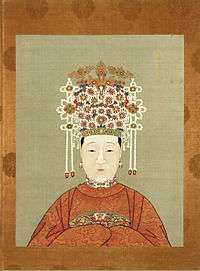Empress Dowager Xiaojing
Empress Dowager Xiaojing (Chinese: 孝靖太后), surnamed Wang, was a Ming dynasty concubine of the Wanli Emperor and the biological mother of the Taichang Emperor. She was primarily known during her lifetime as Consort Gong (Chinese: 恭妃), but is most commonly referred to by her posthumous name.[1]
| Empress Dowager Xiaojing 孝靖太后 | |||||
|---|---|---|---|---|---|
 Empress Dowager Xiaojing | |||||
| Born | February 27, 1565 | ||||
| Died | October 18, 1611 (aged 46) Jingyang Palace, Forbidden City, Beijing | ||||
| Burial | |||||
| Spouse | Wanli Emperor | ||||
| Issue | Zhu Changluo, Taichang Emperor Zhu Xuanyuan, the Princess Yunmeng | ||||
| |||||
| Clan | Wang (王) | ||||
| Father | Wang Chaocai (王朝寀) | ||||
| Mother | Lady Ge (葛氏) | ||||
Life
Wang joined the imperial court as a palace lady in the service of Empress Dowager Xiaoding. The Wanli Emperor met her whilst visiting his mother and began a relationship with her.[2]
When Wang became pregnant, the emperor ignored her. Empress Dowager Xiaoding questioned her son and advised him to marry Wang, as he still had no sons. In the fourth lunar month of 1582, Wang was given the rank of Consort and the honorific Gong.[2] Four months later, she gave birth to a son, who was given the name Zhu Changluo.[3] Shortly before this in the same year, Empress Xiaoduanxian, the emperor's primary wife, had given birth to a daughter; the Princess Rongchang.[4]
In 1584, Wang had a daughter named Zhu Xuanyuan (朱軒嫄).[5]
Succession dispute
Although Wang had given birth to the emperor's eldest son, the emperor's favourite concubine was Noble Consort Zheng, who also had a son. When the Wanli Emperor conferred the status of Imperial Noble Consort on Zheng in 1586, it became apparent to the court that he intended for her son, Zhu Changxun, to inherit the throne, which triggered more than a decade of court factionalism and conflict.[6] This included attempts by officials to raise Wang's status to Noble Consort.[7] Eventually, Wang's son was proclaimed heir apparent in 1601, as a result of pressure from both officials and Empress Dowager Xiaoding. However, Zhu Changxun was not dispatched to his provincial command in keeping with imperial customs until 1604.[8]
In 1605, Wang was made Imperial Noble Consort.[9] In 1606, the emperor conferred upon Wang the honorific name of Cisheng (慈圣) to celebrate the birth of Zhu Changluo's first son.[2]
References
Citations
- Cai (2009), p. 56.
- Zhang (1739).
- History Office (1620s), volume 127.
- Qian (1700), volume 31.
- History Office (1620s), volume 151.
- Huang (1988), pp. 516-517.
- History Office (1620s), volume 171.
- Huang (1988), p. 517.
- History Office (1620s), volume 418.
Cited sources
- Cai, Shishan (蔡石山) (2009). 明代的女人 [Women of the Ming Dynasty] (in Chinese). Linking Publishing. ISBN 9789570834819.CS1 maint: ref=harv (link)
- History Office, ed. (1620s). 明實錄•神宗實錄 [Veritable Records of the Ming: Veritable Records of Shenzong] (in Chinese). Ctext.CS1 maint: ref=harv (link)
- Huang, Ray (1988). "The Lung-ch'ing and Wan-li reigns, 1567–1620". In Mote, Frederick W.; Twitchett, Denis (eds.). The Ming Dynasty, 1368–1644, Part 1. The Cambridge History of China. 7. Cambridge, England: Cambridge University Press. pp. 511–584. doi:10.1017/CHOL9780521243322.008. ISBN 9781139054751.CS1 maint: ref=harv (link)
- Qian Fang 錢枋, ed. (1700). "《萬曆野獲編》第三十一卷 補遺一" [Compilation of spaces conquered by Wanli]. open-lit (in Chinese). Open-lit. Retrieved 10 February 2017.CS1 maint: ref=harv (link)
- Zhang, Tingyu; et al., eds. (1739). "《明史》卷一百十四 列传第二" [History of Ming, Volume 114, Historical Biography 2]. Lishichunqiu Net (in Chinese). Lishi Chunqiu. Retrieved 14 February 2017.CS1 maint: ref=harv (link)